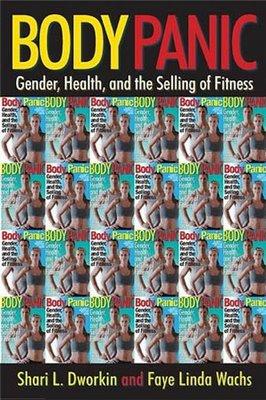Body Panic: Gender, Health, and the Selling of Fitness

Much has been made of representations of bodies, women’s bodies especially, in the media; this terrain is heavily traversed, particularly in feminist discourse. Magazines can be particularly insidious culprits of spreading rigid body doctrines, and for this they have been criticized and pulled apart in many ways. What makes Body Panic: Gender, Health, and the Selling of Fitness different is that Shari L. Dworkin and Faye Linda Wachs are relentless in their pursuit of a comprehensive, empirical study of the ways in which both women’s and men’s bodies are represented in mainstream fitness magazines.
Smiling and posing from the racks as mainstream America waits in line at the grocery store, male and female fitness models shine as beacons of wellness. Oiled, buffed, flexed, but above all sexy, these men and women represent a promise of a better life within the covers. Fitness magazines preach a doctrine no less rigid or demanding than the imperatives of the fashion industry to be thin or the cosmetic industry to be beautiful; however, they do so behind the shield of “health” that so often keeps them from harsher criticism. Dworkin and Wachs dismantle the concept of “healthism” in Body Panic, exposing the ways in which the fitness industry packages and sells a narrow and constrictive version of wellness as a one-size-fits-all prescription to happiness, sex appeal, a long life, and more.
If one only works hard enough, and wants it badly enough, the magazines preach, dreams of “health” and “fitness” can be realized. Based on gender, however, one’s goals should be different. Dworkin and Wachs examined a cross-section of mainstream magazines for both men and women over a span of about ten years, and used a detailed rubric to break down the differences and similarities between them, particularly the cover photographs. The discrepancies, while not surprising, are nonetheless indicative of the unequal ways women’s and men’s bodies are displayed and consumed.
Body Panic takes a fresh look at the diet and exercise industries; Dworkin and Wachs show us that no one, woman or man, young or old, is safe from the pervasiveness and influence of these powerful money-making machines. By no means suggesting that individuals ignore or disregard their “health,” they rather implore us to be critical of media sources we consume, particularly when it comes to our bodies. It is no surprise that the diet and exercise industries consistently make top dollar in the United States—by creating morally superior imperatives and edicts of fitness, and by repackaging the health of our bodies into something that can be bought, these industries ensure that their customers will continue to chase, and pay for, through money or social capital, the health ideal they have fabricated. An ideal so strictly policed is always worth dissecting, and Shari L. Dworkin and Faye Linda Wachs have done this in top form in Body Panic.